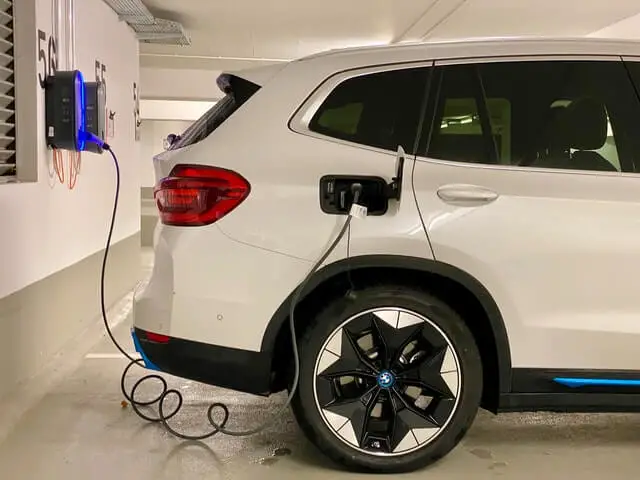Last Updated on July 5, 2024 by Rose Morah
With different types of electric vehicles in the market, it is easy to get confused if you’re looking for an EV that best suits your needs.
To help you understand in the simplest way possible, this article covers the different types of electric vehicles and the type of EV that best suits you.
Types of Electric Vehicles
The following are the 4 main types of electric vehicles:
- Battery Electric Vehicles (BEV)
- Plug-In Hybrid Electric Vehicle (PHEV)
- Hybrid
- Fuel Cell Electric Vehicles (FCEV)
Related: Best EVs That Are Cheaper Than Tesla (Under $40,000).
1. Battery Electric Vehicles (BEV)/ EV
These EVs are fully operated through the power generated from a charged battery. This means that they are 100% electric.
Most people know them as just EVs. However, their technical term is BEV.

| The difference between BEV and other gasoline vehicles is that; -They do not have a combustion engine. -They do not have a gas tank. -They do not use gasoline. -Have no tailpipe. -They have large electric motors. -Most of these EVs have a shorter range compared to gasoline vehicles. However, most EV manufacturers are now focusing heavily on increasing the range. For example by adding dual batteries e.t.c |
Related: How Do EVs and EV Batteries Work?
Since these types of EVs fully rely on the battery, their battery sizes are usually large to allow them to cover reasonable miles.

And again, their battery capacities mostly range from around 32kWh to 100kWh, depending on the model and price of the EV.
What do you need to know before going completely electric?
There are many important things you need to know, but the most important is to understand the term Kilowatt-hour (kWh).
If you are new to the term, kWh is the quantity of electricity.
In simpler terms, kWh in EVs is the amount of electricity you can store and use on an Electric Vehicle. The battery size of an electric car is measured in kWh.
BEVs is best for:
- Home owners.
- People who have more than one car.
- People who have consistent access to a 240V home charger, if you drive more than 30 miles per day.
See the different types of EV charging and EV plugs.
Examples of these types of EVs include:
- Tesla Models.
- BMW i3.
- Volkswagen ID.4.
- Chevy Bolt.
Here is a complete guide to buying a Tesla (what to know before ordering a Tesla)
You also like the 2023 Cadillac Lyriq Debut Edition Features (Smart Features, Price, Range).
2. Hybrid Electric Vehicles (HEV)
These types of vehicles have both combustion engines and battery-powered electric motors but are 100% gas-fueled.
Hybrid Electric Vehicles are fully fueled because their batteries cannot be charged the normal way most EVs are plugged in on charging stations.
The HEVs sometimes use electricity, sometimes gas but often use both.
However, most of them use the electric motor when driving at low speeds while the combustion engine is used when driving at high speeds in order to give you maximum efficiency.
You may also like the Pros and Cons of Volkswagen ID.4 Pro.
So, where does electricity for charging the Hybrids’ battery come from?
It mostly comes from breaking.
They have regenerative braking; the electric motor becomes the generator, and the generated power is then transferred to the battery.
Additionally, the HEVs recycle the wasted energy in order to reduce the use of gasoline, and for efficiency (to drive faster).
Hybrids are known for their ability to help improve the fuel economy because you get to save more on the gas money.
Hybrid Electric Vehicles have the following main features;
- Combustion engine.
- Electric motor.
- Transmission that combines the combustion engine and the electric motor.
- Small battery pack.
- Fuel tank.
HEV is best for people who;
- Are looking for high gas mileage vehicles.
- Live in locations where public infrastructures are not available.
- Live in apartments/those who are unable to install an EV charger at their homes.
Examples of Hybrid cars are;
- Honda Insight
- Hyundai Sonata Hybrid
- Ford Escape
See also: What To Know Before Buying a Nissan Leaf.
3. Plug-in Hybrid Electric Vehicles (PHEV)
PHEV types of vehicles can be plugged-in and also use both the combustion engine and a powered motor.
They also have a gas tank and battery. Their battery pack is of medium size.
How does the PHEV work?
When you run out of charge, the gas engine takes over and automatically powers the car like a regular gasoline vehicle.
However, it is also important to note that some of these Plug-in Hybrid Electric Vehicles will turn the gasoline engine on even if you have a full charge, just to give you an extra acceleration.
PHEV usually displays two ratings when driving:
- Electric + Gasoline
This will show you the charge time, kWh per mile, and gallons per mile.
- Regular Gasoline
This will show you the MPG ( gallons per mile)
See also: Hyundai Kona Electric Pros and Cons (According to Owners).
Benefits of owning a Plug-in Hybrid Electric Vehicle
- If you drive for less than 30 miles a day, you might end up not buying gas for days. This is because it can cover short distances from about 17 to 55 miles (35 to 80 km) without using the combustion engine.
- Low fuel consumption.
- It can fully charge after just a few hours. Most PHEVs can fully charge in under 4 hours when using level 2 charger.
PHEVs are best for people who:
- Are home owners.
- Have access to EV chargers at home and at the workplace.
Here is what to consider before installing an EV home charger.
Examples of Plug-in Hybrid Electric Vehicles
- Kia Niro Plug-In Hybrid.
- 2021 Honda Clarity.
- 2021 Mitsubishi Outlander PHEV.
- 2021 Jeep Wrangler 4xe.
What’s the main difference between Hybrids and Plug-In Hybrid?
The following are 4 main differences between Hybrids and Plug-In Hybrid
| Hybrid Electric Vehicle | Plug-In Hybrid Electric Vehicle | |
| 1. | Hybrid does not require you to change your lifestyle. You will still stop at the gas station as you normally do. | There is definitely going to be a change in lifestyle. Because you will have to plan and remember to charge the vehicle. |
| 2. | You will still need to spend money on gas. | You do not have to spend money on gas. When fully charged, you may go for days if you drive for a few miles a day. Additionally, they have a larger battery pack compared to the Hybrid Electric Vehicle, which makes them possible to run entirely on electricity. |
| 3. | You do not need to have access to an EV charger because charging is not required at all. | You need to have access to a charger both at home and at work. |
| 4. | They are less expensive compared to Plug-In Hybrids. | They are more expensive compared to Hybrid Electric Vehicles. |
Check out the best EV home chargers(EVSE) according to EV owners & experts.
Hybrid VS. Plug-In Hybrid, which one should you buy?
It purely depends on your situation.
To help you make a better decision, here is what you need to consider:
- How many miles do you cover in a day? If you cover lesser miles then Plug-In Hybrid could be a better option.
- Do you live in locations that offer Electric Vehicle Incentives?
If you live in locations that offer great EV incentives, this could greatly reduce the cost of Plug-In Hybrids.
And sometimes if the price is so much closer to the price of normal Hybrids, then this would mean that the Plug-In Hybrid is the better option.
- Does your location have cheap electricity rates compared to the cost of gas? or do you live at locations that enjoy time of use on electricity?
If yes, a Plug-In Hybrid would be the best option. But if that’s not the case then you may want to consider the Hybrid Electric Vehicle.
4. Fuel Cell Electric Vehicles (FCEV)
The Fuel Cell Electric Vehicles combines hydrogen with oxygen in the air to generate electricity that powers their electric motors.
These types of vehicles store hydrogen gas in the tank and use electric motors the same way the battery electric vehicles do.
The difference between these types of EVs and the Battery Electric Vehicle is that with FCEV, you don’t have to plug in to charge. Their fuel cells are recharged by refilling the hydrogen.
Hydrogen + Water = Electricity + Water
NOTE: These types of EVs are rarely available.
In conclusion, whether you decide to go for Battery Electric Vehicles (BEV), Hybrid Electric Vehicle (HEV), or the Plug-In Hybrid Electric Vehicle (PHEV) one of the downsides of these types of vehicles is, you need to be prepared to wait for long periods before you receive your EV after purchasing.
In some locations/countries, it can take up to 1 year, especially if you are going for a popular EV.




